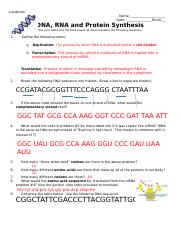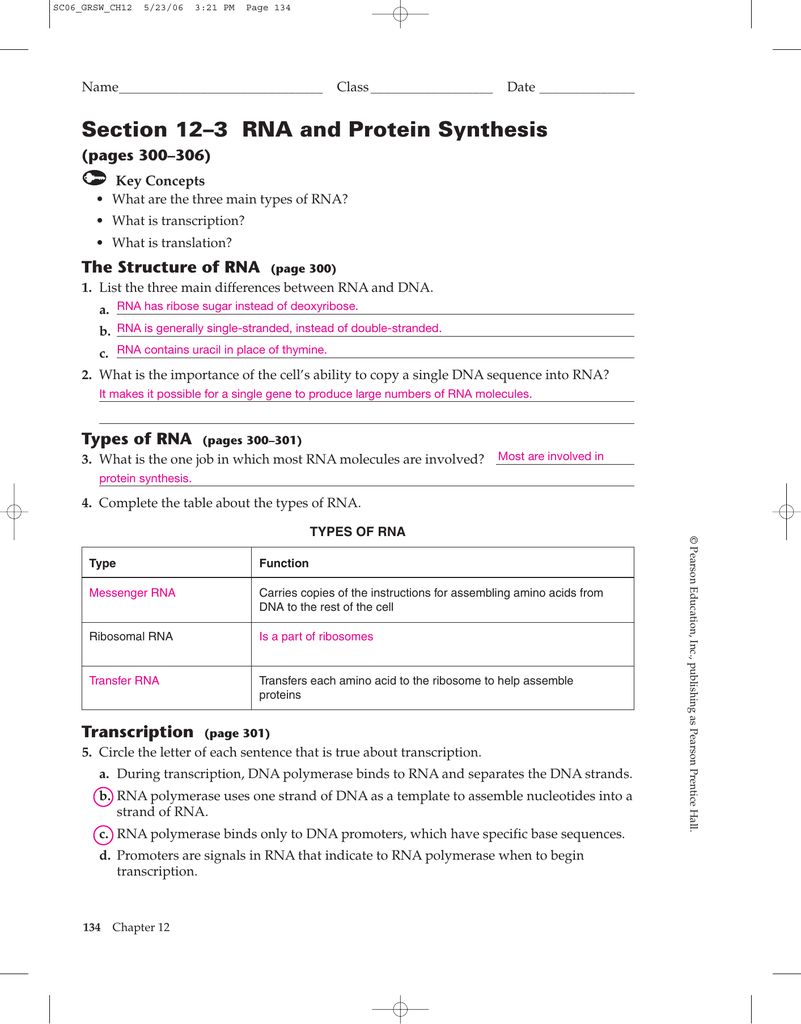Have you ever wondered how a tiny fertilized egg, containing the blueprint of a future human, develops into a complex organism with trillions of cells, each carrying out specific functions? The answer lies within the intricate world of DNA, RNA, and protein synthesis. It’s a captivating symphony of molecular interactions, each step orchestrated by a precise code that determines an individual’s traits, from eye color to disease susceptibility. This study guide is your roadmap to unraveling the mysteries of this fascinating process.

Image: koyumprogram.blogspot.com
Imagine sitting in your biology class, engrossed in a complex diagram of a double helix, proteins weaving in and out, and a flurry of chemical reactions. It’s daunting, to say the least. But fear not! This guide is your companion, breaking down complex concepts into manageable chunks and providing a comprehensive overview of DNA, RNA, and protein synthesis, leaving you with a deeper understanding of the fundamental processes that make life possible.
Decoding the Central Dogma of Molecular Biology
At the core of molecular biology lies the central dogma, a concept that elucidates the flow of genetic information within a cell. It’s like a chain reaction, starting with the DNA molecule, the instruction manual of life, and ending with the synthesis of proteins, the workhorses of the cell.
The Blueprint: DNA
DNA, or deoxyribonucleic acid, is the molecule that holds the genetic instructions for every living organism. Its structure resembles a twisted ladder, with two strands of nucleotides, each a combination of a sugar, a phosphate group, and a nitrogenous base. These bases, adenine (A), thymine (T), cytosine (C), and guanine (G), pair up in a specific way, A with T and C with G, forming the rungs of the ladder. This precise sequence of bases, known as the genetic code, determines the traits of an organism.
The Messenger: RNA
DNA, residing in the nucleus of a cell, is too precious to venture out. So, it employs a messenger, RNA, or ribonucleic acid, to carry the genetic instructions from the nucleus to the ribosomes, the protein-making factories of the cell. RNA is similar to DNA, but with a few key differences. It uses uracil (U) instead of thymine (T) as a base and has a single strand rather than a double helix. There are three main types of RNA: messenger RNA (mRNA), transfer RNA (tRNA), and ribosomal RNA (rRNA).

Image: martindxmguide.blogspot.com
The Workhorse: Protein
Proteins are the building blocks of life, carrying out a myriad of functions within the cell. They act as enzymes, speeding up chemical reactions, form structural components like hair and nails, transport molecules, and even regulate gene expression. The sequence of amino acids in a protein determines its shape and function, and this sequence is dictated by the genetic code carried by mRNA.
The Masterful Dance: Transcription and Translation
The journey from DNA to protein involves two crucial steps: transcription and translation. Think of them as stages in the production line, each with its specific role.
Transcription: DNA to RNA
Transcription is the process of copying the DNA code into an RNA molecule. It occurs in the nucleus, where a specific enzyme, RNA polymerase, unwinds the DNA double helix and uses one strand as a template to build a complementary RNA strand. This nascent RNA molecule, called pre-mRNA, undergoes further processing before exiting the nucleus as mature mRNA.
Translation: RNA to Protein
Translation is the process of translating the RNA code into a protein. It occurs in the ribosomes, where mRNA attaches and is read by tRNA. tRNA molecules, shaped like a cloverleaf, carry specific amino acids based on their anticodon, which complements the codon on the mRNA. As the ribosome moves along the mRNA, tRNA molecules deliver the appropriate amino acids, forming a chain that eventually folds into a functional protein.
Unveiling the Secrets: The Latest Trends in DNA, RNA, and Protein Synthesis
Research in genetics and molecular biology is constantly evolving, uncovering new insights and applications. From CRISPR-Cas9 gene editing technology to personalized medicine, advancements in this field are transforming our understanding of life and its potential for disease treatment and prevention.
Unlocking the Potential: Tips and Expert Advice for Your Studies
Learning about DNA, RNA, and protein synthesis can be challenging, but with the right approach, you can transform this complex process into a captivating journey of knowledge.
- Visualize the process: Don’t just read about it, draw diagrams or use online tools to create visual representations. This will help you understand the spatial arrangement of molecules and their interactions.
- Use analogies: Think of DNA as a blueprint, RNA as a messenger, and proteins as the end product. These analogies will help make the concepts more relatable.
- Break it down into smaller chunks: Don’t try to grasp everything at once. Focus on one step at a time, ensuring a clear understanding before moving to the next.
- Practice, practice, practice: Answer practice questions, work through exercises, and engage in self-testing to solidify your knowledge.
- Connect concepts: Explore the interplay between DNA, RNA, and protein synthesis in different biological contexts. How does the process differ in bacteria compared to eukaryotes?
By implementing these tips, you can transform complex concepts into accessible knowledge and unlock the fascinating world of DNA, RNA, and protein synthesis.
FAQ: Addressing Your Questions
What are the differences between DNA and RNA?
DNA is a double-stranded helix that carries the genetic code, while RNA is a single-stranded molecule that acts as a messenger for the code. DNA uses thymine (T) as one of its bases, while RNA uses uracil (U). DNA resides in the nucleus, while RNA can be found in the nucleus, cytoplasm, and ribosomes.
What is the role of ribosomes in protein synthesis?
Ribosomes are the protein-making factories of the cell. They attach to mRNA and read its code in order to assemble the correct sequence of amino acids for the protein being synthesized.
What are the differences between transcription and translation?
Transcription is the process of copying the DNA code into mRNA, while translation is the process of translating the mRNA code into a protein. Transcription occurs in the nucleus, while translation occurs in the ribosomes.
What are the implications of genetic mutations on protein synthesis?
Genetic mutations can alter the sequence of nucleotides in DNA, which can lead to changes in the mRNA sequence and ultimately the protein sequence. These changes can have a variety of effects on protein function, ranging from minor alterations to complete loss of function, resulting in varying levels of impact on an individual’s health.
Dna Rna And Protein Synthesis Study Guide Answer Key
A Journey of Discovery: Your Next Steps
This study guide has provided a foundation for understanding the fundamental processes of DNA, RNA, and protein synthesis. But the journey doesn’t end here. There is a wealth of information and research unfolding constantly in this field. Explore online resources, delve into scientific journals, and stay updated on the latest advancements in genetics and molecular biology.
Are you intrigued by the intricate dance of molecules that defines life? Share your thoughts and questions below and join the conversation! We can delve deeper into specific aspects of this fascinating topic or explore the applications of this knowledge in fields like medicine, agriculture, and biotechnology.






